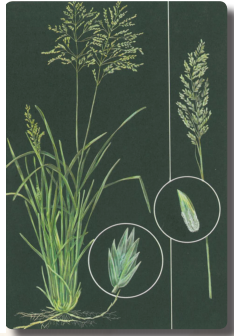Difference between revisions of "Important grazing species"
| Line 8: | Line 8: | ||
* [[ Kentucky bluegrass ]] | * [[ Kentucky bluegrass ]] | ||
| − | Kentucky bluegrass provides good grazing and tolerates[[File:Kentucky_bluegrass.png|thumb|The species is highly palatable to horses, | + | Kentucky bluegrass provides good grazing and tolerates[[File:Kentucky_bluegrass.png|thumb|Kentucky bluegrass: The species is highly palatable to horses, |
cattle, and sheep. It produces relatively low yields | cattle, and sheep. It produces relatively low yields | ||
compared to other pasture grasses, but can be very | compared to other pasture grasses, but can be very | ||
| Line 18: | Line 18: | ||
height of 2 and 6 inches. Crude protein can be 20% at maturity. | height of 2 and 6 inches. Crude protein can be 20% at maturity. | ||
| − | [[ Sand bluestem ]] | + | *[[ Sand bluestem ]] |
Sand bluestem (Andropogon hallii) is a native, warm-season grass that grows 3 to 8 feet tall. Leaves grow 8 to 12 inches | Sand bluestem (Andropogon hallii) is a native, warm-season grass that grows 3 to 8 feet tall. Leaves grow 8 to 12 inches | ||
long. It is adapted to sandy soils and helps bind them with its sod-forming growth habit. Sand bluestem provides good summer grazing and is | long. It is adapted to sandy soils and helps bind them with its sod-forming growth habit. Sand bluestem provides good summer grazing and is | ||
relished by all classes of livestock. It has only fair palatability in the winter | relished by all classes of livestock. It has only fair palatability in the winter | ||
| − | [[Meadow brome ]] | + | *[[Meadow brome ]] |
Meadow brome (Bromus biebersteinii) is a cool-season grass that originated | Meadow brome (Bromus biebersteinii) is a cool-season grass that originated | ||
in Southeast Asia. It is a bunchgrass with short rhizomes and grows 24 to 48 | in Southeast Asia. It is a bunchgrass with short rhizomes and grows 24 to 48 | ||
Revision as of 17:04, 17 February 2015
Important Grazing Plant Species
Understanding appropriate plant species for grazing in specific environments increases forage production and quality, encourages animal health, and discourages weed invasion. It protects soil and increases water infiltration rates and soil organic matter content.
Great Plains of North America
Colorado
Kentucky bluegrass provides good grazing and toleratestrampling but is not highly productive. Overgrazing or undergrazing bluegrass for short periods is not harmful. Because it tolerates trampling and overgrazing, it works well as a component of horse pastures. Keep between a height of 2 and 6 inches. Crude protein can be 20% at maturity.
Sand bluestem (Andropogon hallii) is a native, warm-season grass that grows 3 to 8 feet tall. Leaves grow 8 to 12 inches long. It is adapted to sandy soils and helps bind them with its sod-forming growth habit. Sand bluestem provides good summer grazing and is relished by all classes of livestock. It has only fair palatability in the winter
Meadow brome (Bromus biebersteinii) is a cool-season grass that originated in Southeast Asia. It is a bunchgrass with short rhizomes and grows 24 to 48 inches tall. Meadow brome is adapted to irrigated sites with silt to clay soil. It has some drought tolerance to withstand less than full-season irrigation. Meadow brome establishes rapidly and is more winter hardy than other irrigated grasses like orchardgrass. Meadow brome is a good competitor, but is not as aggressive as smooth brome. It recovers faster than smooth brome from haying or grazing. Meadow brome is highly desired by livestock and wildlife.
